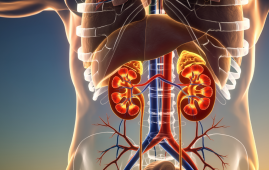

The ovaries of a woman function similarly to a factory, growing eggs and producing hormones that control everything from mood and bone density to menstruation and conception. Ovarian health, however, declines as she and her factory get older, and by the time she reaches menopause (average age 51), the factory is almost ready to close.
A novel approach of extending the “healthspan” of this factory has been found in a recent Northwestern Medicine study involving mice. It involves maintaining the ovaries better and preventing important aging-related alterations in ovarian function. The term “healthspan” describes how long a person stays well and is free from serious illnesses or long-term conditions.
“The average age of menopause has stayed constant over the years, but women are living decades longer than that because of health and medical advances. We’ve changed the landscape of how we live, and our ovarian function needs to catch up so that we have an organ that functions proportionately to maintain women’s healthspans longer.” – Francesca Duncan, corresponding author, associate professor of obstetrics and gynecology (reproductive science in medicine) at Northwestern University Feinberg School of Medicine
The results will appear in the journal GeroScience on September 16.
Pirfenidone, which is frequently used to treat idiopathic pulmonary fibrosis, was used by the researchers in this investigation. However, additional research is being done to find the best medication targets for ovarian fibrosis and to carry out clinical trials on female patients.
“This drug is not one that can be used in a clinical setting for this purpose because it has significant side effects, like liver toxicity, although we didn’t see that in mice,” Duncan explained. But we have proven that we can control ovarian fibrosis and get better results. Now, we’re working hard to discover a medication that works well and is safe for use in people.”
Implications of older age-related stiffer ovaries
Duncan’s lab was the first to discover in a prior study that ovaries age-related hyperinflammation, fibrosis, and stiffness are similar to scarring in other tissues. Duncan explained that old ovaries create an ideal habitat for cancer cells to multiply since cancer cells like stiff, collagen-rich surroundings.
The previous study discovered that stiff ovaries also have an impact on egg quality, which may help explain why women’s fertility decreases in their 30s and 40s.
In the latest study, mice given medicine to lessen ovarian scarring had increased numbers of follicles, better ovulation, and normal hormone levels.
“Right now, our solutions for the age-related decline in fertility, such as freezing one’s eggs, are a Band-Aid,” Duncan stated. “You’re still going to be transferring those embryos into an older woman, which has its own risks.”
The study’s ultimate goal is not to push the fertile window.
According to Duncan, extending a woman’s window for conception is just one factor in the whole picture.
“We’re likely going to push the fertile window, but that is not the ultimate goal of the study,” Duncan stated. “Not everyone is concerned about having children.”
The goal of this research is to better understand how to maintain the ovarian environment for a woman’s ability to produce vital hormones far into her senior years. Osteoporosis risk is increased due to the acceleration of bone loss caused by decreased levels of progesterone and estrogen.
In addition to increasing the risk of cardiovascular disease, low hormones can weaken the vaginal wall, which can cause discomfort during sex or urinary problems, as well as lower mood and cognitive performance.
“If you fix the ovarian environment, you solve all the problems because you have follicles and eggs that can contribute to fertility and hormone production,” Duncan stated. “It’s fixing the root of the issue.”
The research is entitled, “Systemic low‐dose anti‐fibrotic treatment attenuates ovarian aging in the mouse.” The Global Consortium for Reproductive Longevity and Equality funded the research.
For more information: Systemic low-dose anti-fibrotic treatment attenuates ovarian aging in the mouse, Northwestern University, https://doi.org/10.1007/s11357-024-01322-w
more recommended stories
 Gestational Diabetes Risk Identified by Blood Metabolites
Gestational Diabetes Risk Identified by Blood MetabolitesKey Takeaways (Quick Summary for Clinicians).
 Phage Therapy Study Reveals RNA-Based Infection Control
Phage Therapy Study Reveals RNA-Based Infection ControlKey Takeaways (Quick Summary) Researchers uncovered.
 Pelvic Floor Disorders: Treatable Yet Often Ignored
Pelvic Floor Disorders: Treatable Yet Often IgnoredKey Takeaways (Quick Summary) Pelvic floor.
 Urine-Based microRNA Aging Clock Predicts Biological Age
Urine-Based microRNA Aging Clock Predicts Biological AgeKey Takeaways (Quick Summary) Researchers developed.
 Circadian Control of Neutrophils in Myocardial Infarction
Circadian Control of Neutrophils in Myocardial InfarctionKey Takeaways for HCPs Neutrophil activity.
 E-Cigarette Use and Heart Attack Risk in Former Smokers
E-Cigarette Use and Heart Attack Risk in Former SmokersKey Takeaways for Clinicians and Nurses.
 36-Week Pre-eclampsia Screening May Reduce Term Risk
36-Week Pre-eclampsia Screening May Reduce Term RiskA New Preventive Strategy for Term.
 Cardiovascular Risk and Sudden Cardiac Death in Diabetes
Cardiovascular Risk and Sudden Cardiac Death in DiabetesRising Sudden Cardiac Death (SCD) Risk.
 Poor Kidney Function and Alzheimer’s Biomarkers Explained
Poor Kidney Function and Alzheimer’s Biomarkers ExplainedPoor kidney function may influence levels.
 Walking Speed Before Hip Replacement Predicts Recovery
Walking Speed Before Hip Replacement Predicts RecoveryNew Evidence Points to a Simple,.

Leave a Comment